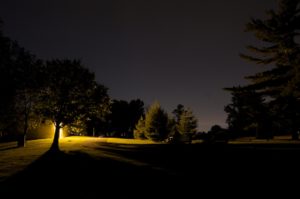This evening I attended a presentation of the documentary “Karsh Is History” at the Library and Archives building on Wellington. BTW, I hate that title, as it seems rather inappropriate for a deceased person. It was about an hour long.
Which worked out well for me, as I wanted to go outside to get a picture of the International Space Station fly-over, which occurred tonight between 8:31 and 8:36pm. I wanted to have an arc of the ISS light over a long exposure of the sky (i.e. like star trails). I learned the following valuable lessons.
- Choose a location ahead of time. I had to find a good location that was less than 16 minutes from the Archives building. I thought either the Alexandra Bridge near the National Gallery or perhaps somewhere along the Ottawa River Parkway. I choose to find a spot along the river. There really is only one spot with a parking lot (near Tunney’s Pasture), and it was open. But it was also not lit. It was very dark, and a little scary as there were other cars parked there and I could not see the owners in the dark. I ran out to the waterline with my camera and tripod, but the view of the sky was not very good. I found a cornfield in Barrhaven that would have a good view of the sky for the ISS flyover when I try this experiment again. The cornfield is naturally also dark.
- Be prepared. I didn’t have a flash light, so I was using my cell phone to provide some light in order to see what I was doing with the camera. I also think a true wide-angle lens would be better. My EF-S 17-55mm f/2.8 IS is equivalent to 27mm which is not wide enough.
- The weather is critical to capture the sky at night. It was slightly cloudy, especially to the southwest, which was where the ISS flyover would start. The forecast is cloudy or partly cloudy until next Thursday.
- Know your camera. It is very difficult to attempt to figure out how to set a bulb exposure by reading camera buttons with the light from a 12-year old cell phone. I should have known how to do that before I got out of my car to take the picture. It is buried under the Tv (shutter priority) button. I basically know all of the camera controls in daylight, but cannot do the same in the dark.
- Always have a second battery with you. The camera was almost out of battery power. My second battery was in the car, and not in my pocket where it would have been useful for me.
In the end, I did not get a good shot of the ISS. All I have is a white streak on a nearly black background with little context (the outline of a treetop). The ISS is bright to the human eye, but to the camera, it is moving too fast for the camera to get much exposure against the light glow from downtown.

But on my way back to my car, I saw this scene that I had to capture. I think it looks great. Very moody.

